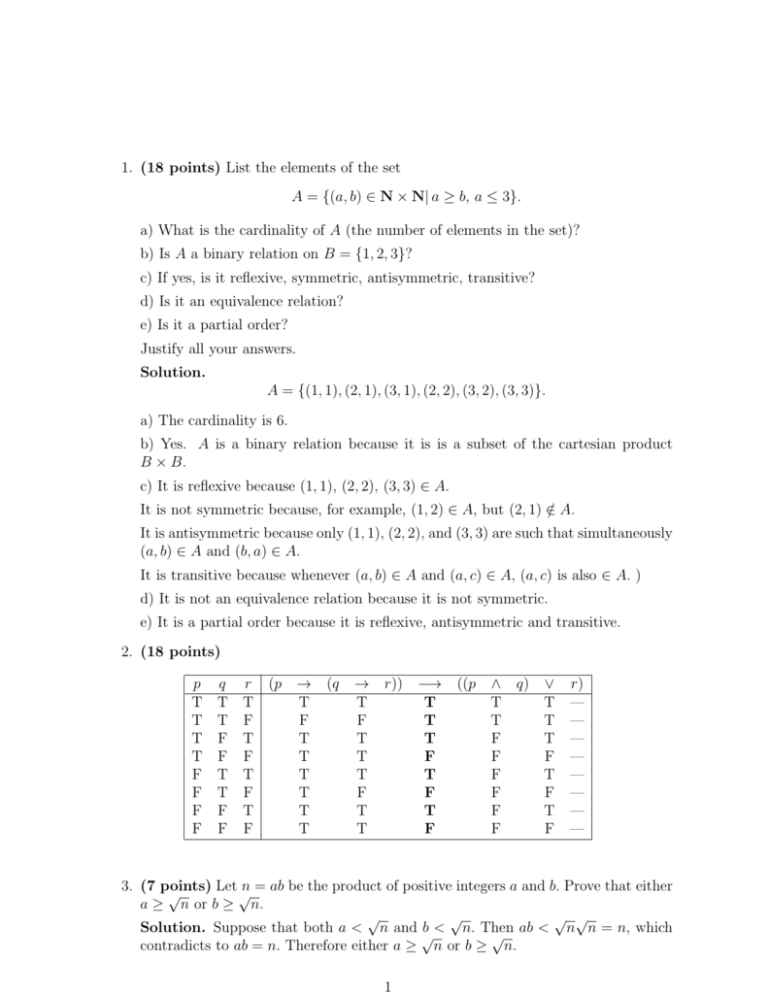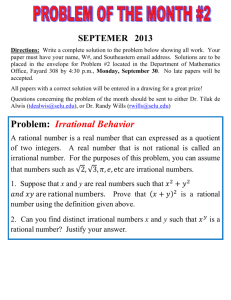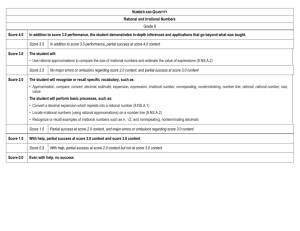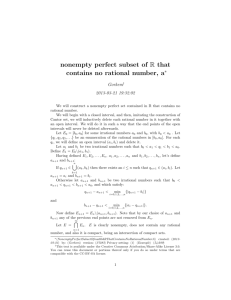Solution
advertisement

1. (18 points) List the elements of the set
A = {(a, b) ∈ N × N| a ≥ b, a ≤ 3}.
a) What is the cardinality of A (the number of elements in the set)?
b) Is A a binary relation on B = {1, 2, 3}?
c) If yes, is it reflexive, symmetric, antisymmetric, transitive?
d) Is it an equivalence relation?
e) Is it a partial order?
Justify all your answers.
Solution.
A = {(1, 1), (2, 1), (3, 1), (2, 2), (3, 2), (3, 3)}.
a) The cardinality is 6.
b) Yes. A is a binary relation because it is is a subset of the cartesian product
B × B.
c) It is reflexive because (1, 1), (2, 2), (3, 3) ∈ A.
It is not symmetric because, for example, (1, 2) ∈ A, but (2, 1) ∈
/ A.
It is antisymmetric because only (1, 1), (2, 2), and (3, 3) are such that simultaneously
(a, b) ∈ A and (b, a) ∈ A.
It is transitive because whenever (a, b) ∈ A and (a, c) ∈ A, (a, c) is also ∈ A. )
d) It is not an equivalence relation because it is not symmetric.
e) It is a partial order because it is reflexive, antisymmetric and transitive.
2. (18 points)
p q r (p
T T T
T T F
T F T
T F F
F T T
F T F
F F T
F F F
→ (q
T
F
T
T
T
T
T
T
→ r)) −→
T
T
F
T
T
T
T
F
T
T
F
F
T
T
T
F
((p
∧ q)
T
T
F
F
F
F
F
F
∨
T
T
T
F
T
F
T
F
r)
—
—
—
—
—
—
—
—
3. (7 points)
Let √
n = ab be the product of positive integers a and b. Prove that either
√
a ≥ n or b ≥ n.
√
√
√ √
Solution. Suppose that both a < n and √
b < n. Then
ab
<
n n = n, which
√
contradicts to ab = n. Therefore either a ≥ n or b ≥ n.
1
4. (14 points) Prove that the sum of a rational and an irrational numbers is an
irrational number.
Solution. Assume a and b be the rational and irrational numbers respectively.
Suppose that c = a + b is a rational number. So we have a = m/n, c = l/k,
where m, n, l, k are integers. So we have l/k = m/n + b, or b = l/k − m/n =
(ln − km)/(kn). ln − km is integer, kn is ineger, therefore b is rational, which
contradicts our asumption. Therefore c cannot be a rational number.
Is a sum of two irrational numbers an irrational number? No. Example: −π +π = 0.
5. (18 points) Determine the validity of the following argument:
If I work hard, then I earn lots of money.
If I earn lots of money, then I pay high taxes.
___________________________________________________
If I do not work hard, then I do not pay high taxes.
Solution. Let a, b and c be the arguments:
a : I work hard
b : I earn lots of money
c : I pay high taxes
Then the given argument is
a→b
b→c
− − −−
¬a → ¬c
Solution. Constructing the truth table you can see that the argument is invalid
e.g. if a is FALSE, b is TRUE and c is TRUE. Then a → b is TRUE, b → c is TRUE
but ¬a → ¬c is FALSE. In other words, if I do NOT work hard but still make lots
of money somehow, I will have to pay high taxes.
6. (7 points) Show that there exists no largest negative rational number.
Solution. Suppose that there exists the largest negative rational number a. Then
another rational negative number b = 0.5a is actually greater than a. Therefore
we come to the contradiction and therefore there exists no largest negative rational
number.
7. (18 points) Prove without the use of Venn diagram that
A ∪ (B ∩ C) = (A ∪ B) ∩ (A ∪ C).
2
Solution1. Let x ∈ A, x ∈ B, and x ∈ C, are logical statement a, b, and c
respectively. So we have
x ∈ A ∪ (B ∩ C) ⇔ x ∈ A or x ∈ B ∩ C ⇔ x ∈ A or both x ∈ B and x ∈ C ⇔
a ∨ (b ∧ c) ⇔ {DeM organ0 s law} ⇔ (a ∨ b) ∧ (a ∨ c) ⇔
both (x ∈ A or x ∈ B) and (x ∈ A or x ∈ C) ⇔
both (x ∈ A ∪ B) and (x ∈ A ∪ C) ⇔ x ∈ (A ∪ B) ∩ (A ∪ C).
Therefore the sets A ∪ (B ∩ C) and (A ∪ B) ∩ (A ∪ C) consist of same elements.
Solution2. Let x ∈ A ∪ (B ∩ C). Then two cases are possible. Case 1: x ∈ A. Then
x ∈ A ∪ B and x ∈ A ∪ C. Then x ∈ (A ∪ B) ∩ (A ∪ C). Case 2: x ∈ (B ∩ C). Then
x ∈ B and x ∈ C. Then x ∈ A ∪ B and x ∈ A ∪ C. Then x ∈ (A ∪ B) ∩ (A ∪ C). Both
cases lead to x ∈ (A ∪ B) ∩ (A ∪ C). Therefore A ∪ (B ∩ C) ⊂ (A ∪ B) ∩ (A ∪ C).
Let x ∈ (A ∪ B) ∩ (A ∪ C). Then x ∈ (A ∪ B) and x ∈ (A ∪ C). Case 1: x ∈ A.
Then x ∈ A ∪ (B ∩ C). Case 2: x ∈
/ A. Then since x ∈ (A ∪ B) and x ∈ (A ∪ C) we
have x ∈ B and x ∈ C. Then x ∈ B ∩ C. Then x ∈ A ∪ (B ∩ C). Both cases lead to
x ∈ A ∪ (B ∩ C). Therefore (A ∪ B) ∩ (A ∪ C) ⊂ A ∪ (B ∩ C).
Since A ∪ (B ∩ C) ⊂ (A ∪ B) ∩ (A ∪ C) and (A ∪ B) ∩ (A ∪ C) ⊂ A ∪ (B ∩ C), we
have (A ∪ B) ∩ (A ∪ C) = A ∪ (B ∩ C).
3








